Design and Implementation of an Enhanced Matched Filter for Sidelobe Reduction of Pulsed Linear Frequency Modulation Radar
Abstract
1. Introduction
- An EMF, combining the MF and the SRF, for LFM waveforms is proposed.
- A derived formula for the frequency response of the SRF is presented, depending on the parameters of the LFM signal and without using any iteration methods or adaptive techniques as used previously in the literature, where the operational principle of the MMF, R-G, Wiener, CLEAN, and APC algorithms depends on either an iteration using least-squares, or optimization of an algorithm parameter to reduce the sidelobes. Additionally, other techniques combine both iteration and optimization methods to reduce the sidelobes [45].
- Since the windowing functions and MMF [8] increase the IRW more than an MF, the proposed EMF keeps the IRW equivalent to that resulting from an MF, hence reserving the resolution. Additionally, it provides a considerable reduction in sidelobes.
2. Derivation of the Sidelobe Reduction Filter (SRF)
- The parameters for pulsed LFM include: MHz, MHz, Mhz, sample size, and sample size.
- These parameters are used in Equation (1) to generate the LFM waveform.
- The generated LFM waveform is then up-converted by the transmitter, and is then propagated by means of the transmit antenna towards three targets (T1:T3). The time domain of base-band transmitted signal, , and the absolute of its FFT, , in Figure 5a,b, respectively. The transmitted signal, , is a complex signal that contains the In-phase (I) and quadrature phase (Q) components.
- The three reflected echoes from the three targets are summed up at the receive antenna; then the receiver down-converts the received signal into a baseband. The amplitude of the reflected echoes, having different RCSs and being located at different ranges, have normalized amplitudes: , , and . Consequently, the received signals are time delayed by numbers of samples: , , and , which correspond to the ranges: m, m, and m, respectively.
- The received signal after down-conversion at receiver, is the sum of echo signal from the three targets, and is expressed by:
- In the frequency domain, the received signal is expressed by:The time domain of baseband received complex signal, , and the absolute of its FFT, , are shown in Figure 6a,b, respectively.
- The conjugate of the transmitted signal is then multiplied by the received signal, , to get the correlation signal in frequency domain, :where is the Fourier transform of the autocorrelation function of the transmitted signal.
- Applying IFFT to to get , which is the output of the MF in time domain. The absolutes of and are shown in Figure 7a,b, respectively.
- The proposed frequency response of the SRF, , is given by:where is the frequency response of the desired output. is obtained by selecting the mainlobe of and zeroing the rest of samples to obtain , and then applying FFT to . The desired outputs in frequency and time domains, and , are shown in Figure 8a,c, respectively. The autocorrelation functions of the transmitted signal in frequency and time domains, and , are shown in Figure 8b,c, respectively. Figure 8e, is shown the frequency response of the SRF, . The denominator, , represents the MF output in frequency domain for a single target. , , and are real signals as shown in Figure 8a,b and e, respectively. Detailed derivations of the general form of the are shown in Appendix A for even and odd numbers of samples. Accordingly, the result of applying on the MF output is the reduction of the sidelobes without considering the transmitted or received LMF waveform.
- The output of the SRF, , is given by:
- Finally the output of the EMF in the time domain, , is obtained via IFFT of :
3. Performance Analysis of the Proposed EMF
3.1. Performance Analysis Considering a Single Target
- Generating the reference LFM waveform, , using Equation (1) with the following parameter values: target range = 200 m, rad/s, MHz, and MHz. Considering three different values for N, 43, 85, and 171, which correspond to three values of time bandwidth product (TBP) of the baseband LFM signal: 32, 64, and 128, respectively, where .
- The reference LFM signal is delayed by the value of the target range to obtain .
- Generating a normalized white Gaussian noise, , with zero mean and unit variance corresponding to SNR values of to 30 dB.
- and are added to obtain , which is the received signal at MF.
- IFFT the output of MF, , to obtain .
- is multiplied by the frequency response of HW, , to obtain . IFFT of to obtain .
- is multiplied by to obtain . IFFT of to obtain .
- Having different performance measures (PSLR, IRW, MLR, and ROC) for the output of three filters; , , and .
- To obtain the ROC, use the smallest-of-cell-averaging (SOF-CA) constant false alarm rate (CFAR) detector, which can detect very close targets [55]. A false alarm probability, , of , is considered.
- For every value of SNR, repeat the previous steps 200 times using a Monte–Carlo simulation. Then, the mean value for each of the four metrics is calculated.
3.2. Ambiguity Function
3.3. Comparison of EMF Performance with Sidelobe Reduction Techniques
3.4. Performance Analysis Considering Multiple Targets
- Case 5, in Figure 18a and Figure 19a: five targets (T1:T5) have ranges of 4, , 8, 11, and 14 cm, respectively. The ultrasonic wave propagates through iron with speed m/sec.The LFM waveform parameters are: , zero-started frequency, , KHz, KHz, MHz, and .
- Case 6, in Figure 18b and Figure 19b: five targets (T1:T5) have ranges of 10, , 20, , and 35 cm, respectively. The ultrasonic wave propagates through sea water with speed m/s.The LFM waveform parameters are: , zero-centered frequency, , KHz, KHz, KHz, and .
4. Practical Proof Using SDR
4.1. Experimental Work in the Laboratory
4.2. Outdoor Experimental Work
5. Conclusions
Author Contributions
Funding
Institutional Review Board Statement
Informed Consent Statement
Data Availability Statement
Acknowledgments
Conflicts of Interest
Appendix A. Derivation of the Frequency Response of the SRF;
Appendix A.1. Derivation of :
- Autocorrelation for the discrete single-pulse LFM signal, , to obtain .
- FFT of to get , which is the input signal of the SRF.
- The desired output signal, , is composed of the samples in the mainlobe of , while zeroing the rest of samples outside the mainlobe.
- FFT of to get .
- The frequency response of the SRF is .
- Manipulating to obtain a compact form.
- For odd N of an LFM waveform with zero-centered frequency and zero-started frequency, and are generated, respectively, which are then combined to get . as shown in Figure A1.
- For even N of an LFM waveform with zero-centered frequency and zero-started frequency, and are generated, respectively, which are then combined to get . as shown in Figure A1.
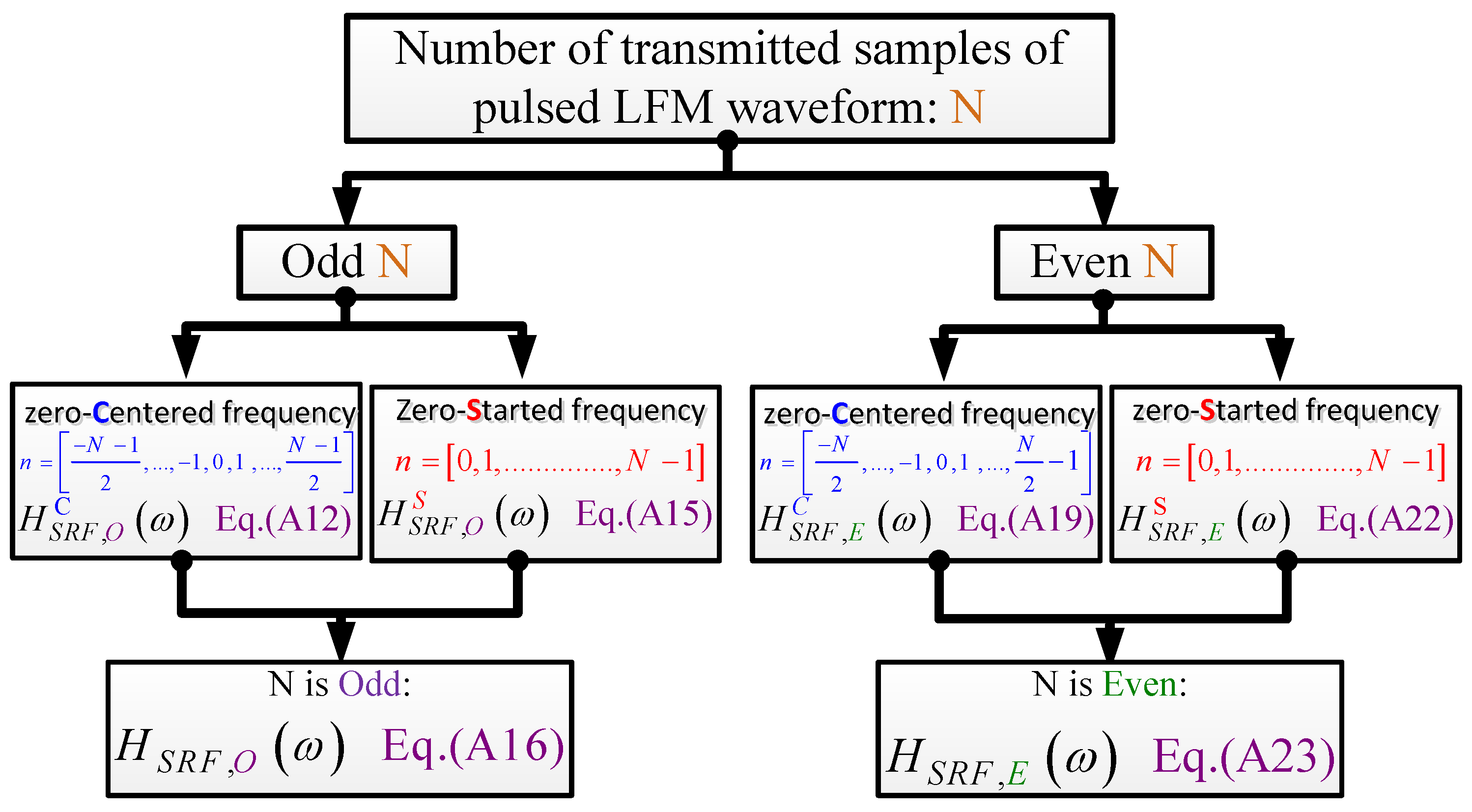
Appendix A.1.1. Derivation of for odd N:
Appendix A.1.2. Derivation of for even N:
References
- Cooke, C.E. The early history of pulse compression radar-the history of pulse compression at Sperry Gyroscope Company. IEEE Trans. Aerosp. Electron. Syst. 1988, 24, 825–833. [Google Scholar] [CrossRef]
- Siebert, W.M. The early history of pulse compression radar-the development of AN/FPS-17 coded-pulse radar at Lincoln Laboratory. IEEE Trans. Aerosp. Electron. Syst. 1988, 24, 833–837. [Google Scholar] [CrossRef]
- Skonlik, M. Radar Handbook, 3rd ed.; McGraw–Hill: New York, NY, USA, 2008. [Google Scholar]
- Michaels, J.E.; Lee, S.J.; Croxford, A.J.; Wilcox, P.D. Chirp excitation of ultrasonic guided waves. Ultrasonics 2013, 53, 265–270. [Google Scholar] [CrossRef]
- Mulaveesala, R.; Vaddi, J.S.; Singh, P. Pulse compression approach to infrared nondestructive characterization. Rev. Sci. Instrum. 2008, 79, 094901. [Google Scholar] [CrossRef]
- Kaiplavil, S.; Mandelis, A. Truncated-correlation photothermal coherence tomography for deep subsurface analysis. Nat. Photonics 2014, 8, 635–642. [Google Scholar] [CrossRef]
- Zhang, Y.X.; Liu, Q.F.; Hong, R.J.; Pan, P.P.; Deng, Z.M. A Novel Monopulse Angle Estimation Method for Wideband LFM Radars. Sensors 2016, 16, 817. [Google Scholar] [CrossRef]
- Blunt, S.D.; Mokole, E.L. Overview of radar waveform diversity. IEEE Aerosp. Electron. Syst. Mag. 2016, 31, 2–42. [Google Scholar] [CrossRef]
- Richards, M.A.; Scheer, J.; Holm, W.A.; Melvin, W.L. Principles of Modern Radar; SciTech Publishing: Raleigh, NC, USA, 2010. [Google Scholar]
- Seleym, A. Complementary phase coded LFM waveform for SAR. In Proceedings of the 2016 Integrated Communications Navigation and Surveillance (ICNS), Herndon, VA, USA, 19–21 April 2016; p. 4C3–1. [Google Scholar]
- Galati, G.; Pavan, G. Range sidelobes suppression in pulse-compression radar using Golay pairs: Some basic limitations for complex targets. IEEE Trans. Aerosp. Electron. Syst. 2012, 48, 2756–2760. [Google Scholar] [CrossRef]
- Levanon, N.; Cohen, I.; Itkin, P. Complementary pair radar waveforms–evaluating and mitigating some drawbacks. IEEE Aerosp. Electron. Syst. Mag. 2017, 32, 40–50. [Google Scholar] [CrossRef]
- Nunn, C.J.; Coxson, G.E. Best-known autocorrelation peak sidelobe levels for binary codes of length 71 to 105. IEEE Trans. Aerosp. Electron. Syst. 2008, 44, 392–395. [Google Scholar] [CrossRef]
- Lewis, B.L.; Kretschmer, F.F. Linear frequency modulation derived polyphase pulse compression codes. IEEE Trans. Aerosp. Electron. Syst. 1982, 5, 637–641. [Google Scholar] [CrossRef]
- Costas, J.P. A study of a class of detection waveforms having nearly ideal range-Doppler ambiguity properties. Proc. IEEE 1984, 72, 996–1009. [Google Scholar] [CrossRef]
- Vizitiu, I.C.; Enache, F.; Popescu, F. Sidelobe reduction in pulse-compression radar using the stationary phase technique: An extended comparative study. In Proceedings of the 2014 International Conference on Optimization of Electrical and Electronic Equipment (OPTIM), Bran, Romania, 22–24 May 2014; pp. 898–901. [Google Scholar]
- Vizitiu, I.C. Some aspects of sidelobe reduction in pulse compression radars using NLFM signal processing. Prog. Electromagn. Res. 2014, 47, 119–129. [Google Scholar] [CrossRef][Green Version]
- Labitt, M. Obtaining Low Sidelobes Using Non-Linear FM Pulse Compression; Technical Report; Lincoln Laboratory, MIT: Lexington, MA, USA, 1994. [Google Scholar]
- Scholnik, D.P. Optimal filters for range-time sidelobe suppression. In Proceedings of the 2000 10th European Signal Processing Conference, Tampere, Finland, 4–8 September 2000; pp. 1–4. [Google Scholar]
- Blunt, S.D.; Jakabosky, J.; Cook, M.; Stiles, J.; Seguin, S.; Mokole, E. Polyphase-coded FM (PCFM) radar waveforms, part II: Optimization. IEEE Trans. Aerosp. Electron. Syst. 2014, 50, 2230–2241. [Google Scholar] [CrossRef]
- Guan, C.; Zhou, Z.; Zeng, X. Optimal Waveform Design Using Frequency-Modulated Pulse Trains for Active Sonar. Sensors 2019, 19, 4262. [Google Scholar] [CrossRef]
- Hedayatrasa, S.; Poelman, G.; Segers, J.; Van Paepegem, W.; Kersemans, M. On the application of an optimized Frequency-Phase Modulated waveform for enhanced infrared thermal wave radar imaging of composites. Opt. Lasers Eng. 2021, 138, 106411. [Google Scholar] [CrossRef]
- Yang, R.; He, Y.; Mandelis, A.; Wang, N.; Wu, X.; Huang, S. Induction Infrared Thermography and Thermal-Wave-Radar Analysis for Imaging Inspection and Diagnosis of Blade Composites. IEEE Trans. Ind. Inform. 2018, 14, 5637–5647. [Google Scholar] [CrossRef]
- Levanon, N.; Mozeson, E. Radar Signals; John Wiley & Sons: Hoboken, NJ, USA, 2004. [Google Scholar]
- Poularikas, A.D. Handbook of Formulas and Tables for Signal Processing; CRC Press: Boca Raton, FL, USA, 1998. [Google Scholar]
- Burrascano, P.; Laureti, S.; Senni, L.; Ricci, M. Pulse compression in nondestructive testing applications: Reduction of near sidelobes exploiting reactance transformation. IEEE Trans. Circuits Syst. Regul. Pap. 2018, 66, 1886–1896. [Google Scholar] [CrossRef]
- Hutchins, D.; Burrascano, P.; Davis, L.; Laureti, S.; Ricci, M. Coded waveforms for optimised air-coupled ultrasonic nondestructive evaluation. Ultrasonics 2014, 54, 1745–1759. [Google Scholar] [CrossRef]
- Liu, M.; Li, Z.; Liu, L. A Novel Sidelobe Reduction Algorithm Based on Two-Dimensional Sidelobe Correction Using D-SVA for Squint SAR Images. Sensors 2018, 18, 783. [Google Scholar] [CrossRef]
- Mahafza, B.R. Radar Systems Analysis and Design Using MATLAB Third Edition; CRC Press: Boca Raton, FL, USA, 2013. [Google Scholar]
- Fam, A.; Sarkar, I. Mismatched Filter. US Patent 7,843,382, 30 November 2010. [Google Scholar]
- Baden, J.; Cohen, M. Optimal sidelobe suppression for biphase codes. In Proceedings of the NTC’91-National Telesystems Conference Proceedings, Atlanta, GA, USA, 26–27 March 1991; pp. 127–131. [Google Scholar]
- Cilliers, J.E.; Smit, J.C. Pulse Compression Sidelobe Reduction by Minimization of Lp-Norms. IEEE Trans. Aerosp. Electron. Syst. 2007, 43, 1238–1247. [Google Scholar] [CrossRef]
- Blunt, S.D.; Cook, M.; Jakabosky, J.; De Graaf, J.; Perrins, E. Polyphase-coded FM (PCFM) radar waveforms, part I: Implementation. IEEE Trans. Aerosp. Electron. Syst. 2014, 50, 2218–2229. [Google Scholar] [CrossRef]
- Kajenski, P.J. Mismatch filter design via convex optimization. IEEE Trans. Aerosp. Electron. Syst. 2016, 52, 1587–1591. [Google Scholar] [CrossRef]
- Rihaczek, A.W.; Golden, R.M. Range sidelobe suppression for Barker codes. IEEE Trans. Aerosp. Electron. Syst. 1971, AES-7, 1087–1092. [Google Scholar] [CrossRef]
- Hua, C.X.; Oksman, J. A new algorithm to optimize Barker code sidelobe suppression filters. IEEE Trans. Aerosp. Electron. Syst. 1990, 26, 673–677. [Google Scholar]
- Akbaripour, A.; Bastani, M.H. Range sidelobe reduction filter design for binary coded pulse compression system. IEEE Trans. Aerosp. Electron. Syst. 2012, 48, 348–359. [Google Scholar] [CrossRef]
- Gini, F.; Rangaswamy, M.; Base, H.A.F. Knowledge Based Radar Detection, Tracking, and Classification; John Wiley and Sons: Hoboken, NJ, USA, 2008. [Google Scholar]
- Gabriel, W.F. Superresolution techniques in the range domain. In Proceedings of the IEEE International Conference on Radar, Arlington, VA, USA, 7–10 May 1990; pp. 263–267. [Google Scholar]
- Gabriel, W.F. Superresolution techniques and ISAR imaging. In Proceedings of the IEEE National Radar Conference, Dallas, TX, USA, 29–30 March 1989; pp. 48–55. [Google Scholar]
- Abramovich, Y.I. A recursive method for the resolution of wideband signals with substantially different intensities. Radio Eng. Electron. Phys 1978, 23, 66–70. [Google Scholar]
- Deng, H. Effective CLEAN algorithms for performance-enhanced detection of binary coding radar signals. IEEE Trans. Signal Process. 2004, 52, 72–78. [Google Scholar] [CrossRef]
- Blunt, S.D.; Gerlach, K. Adaptive pulse compression via MMSE estimation. IEEE Trans. Aerosp. Electron. Syst. 2006, 42, 572–584. [Google Scholar] [CrossRef]
- Blunt, S.D.; Higgins, T. Achieving real-time efficiency for adaptive radar pulse compression. In Proceedings of the 2007 IEEE Radar Conference, Waltham, MA, USA, 17–20 April 2007; pp. 116–121. [Google Scholar]
- Henke, D.; McCormick, P.; Blunt, S.D.; Higgins, T. Practical aspects of optimal mismatch filtering and adaptive pulse compression for FM waveforms. In Proceedings of the 2015 IEEE Radar Conference (RadarCon), Arlington, VA, USA, 10–15 May 2015; pp. 1149–1155. [Google Scholar]
- Li, C.X.; Guo, M.F.; Zhao, H.F. An Iterative Deconvolution-Time Reversal Method with Noise Reduction, a High Resolution and Sidelobe Suppression for Active Sonar in Shallow Water Environments. Sensors 2020, 20, 2844. [Google Scholar] [CrossRef]
- Azouz, A.; Ghanem, S.; Horn, A.; Elbardawiny, A. A New Sidelobe Cancellation Method for LFM Radars. In Proceedings of the 11th International Conference on Electrical Engineering (ICEENG), Cairo, Egypt, 3–5 April 2018; Volume 11, pp. 1–16. [Google Scholar] [CrossRef]
- Azouz, A.; Eldemiry, A.; Horn, A.; Gaafar, A. New SAR Algorithm for Sidelobe Reduction in Range direction. In Proceedings of the 11th International Conference on Electrical Engineering (ICEENG), Cairo, Egypt, 3–5 April 2018; Volume 11, pp. 1–19. [Google Scholar] [CrossRef][Green Version]
- Azouz, A. Novel Sidelobe cancellation for Compound-Barker Combined with LFM or Polyphase Waveform. In Proceedings of the 2020 12th International Conference on Electrical Engineering (ICEENG), Cairo, Egypt, 7–9 July 2020; pp. 268–276. [Google Scholar] [CrossRef]
- Azouz, A. A Modified-Matched Filter for Square Length Polyphase Codes for One Sample per Phase Code. In Proceedings of the 2019 15th International Computer Engineering Conference (ICENCO), Cairo, Egypt, 29–30 December 2019; pp. 17–22. [Google Scholar] [CrossRef]
- Azouz, A. A Modified-Matched Filter for Square Length Polyphase Codes for K Sample per Phase Code. In Proceedings of the 2019 15th International Computer Engineering Conference (ICENCO), Cairo, Egypt, 29–30 December 2019; pp. 1–6. [Google Scholar] [CrossRef]
- Azouz, A. General Sidelobe Cancellation for All Waveform of Pulsed Radars. In Proceedings of the 2020 12th International Conference on Electrical Engineering (ICEENG), Cairo, Egypt, 7–9 July 2020; pp. 258–267. [Google Scholar] [CrossRef]
- Higgins, T.; Blunt, S.D.; Gerlach, K. Gain-constrained adaptive pulse compression via an MVDR framework. In Proceedings of the 2009 IEEE Radar Conference, Pasadena, CA, USA, 4–8 May 2009; pp. 1–6. [Google Scholar]
- Cumming, I.G.; Wong, F.H. Digital processing of synthetic aperture radar data. Artech House 2005, 1, 3. [Google Scholar]
- Weiss, M. Analysis of some modified cell-averaging CFAR processors in multiple-target situations. IEEE Trans. Aerosp. Electron. Syst. 1982, AES-18, 102–114. [Google Scholar] [CrossRef]
- Yang, R.; Li, H.; Li, S.; Zhang, P.; Tan, L.; Gao, X.; Kang, X. High-Resolution Microwave Imaging; Springer: Berlin/Heidelberg, Germany, 2018. [Google Scholar]
- Liu, G.; Zhang, X.; Meng, J. A Small Ship Target Detection Method Based on Polarimetric SAR. Remote Sens. 2019, 11, 2938. [Google Scholar] [CrossRef]
- Harris, V.G.; Sokolov, A.S. The self-biased circulator: Ferrite materials design and process considerations. J. Supercond. Nov. Magn. 2019, 32, 97–108. [Google Scholar] [CrossRef]
- Kong, K.; Kim, H.; Aziz, R.S.; Park, S.O. Design of offset dual-reflector antennas for improving isolation level between transmitter and receiver antennas. Prog. Electromagn. Res. C 2015, 57, 193–203. [Google Scholar] [CrossRef][Green Version]
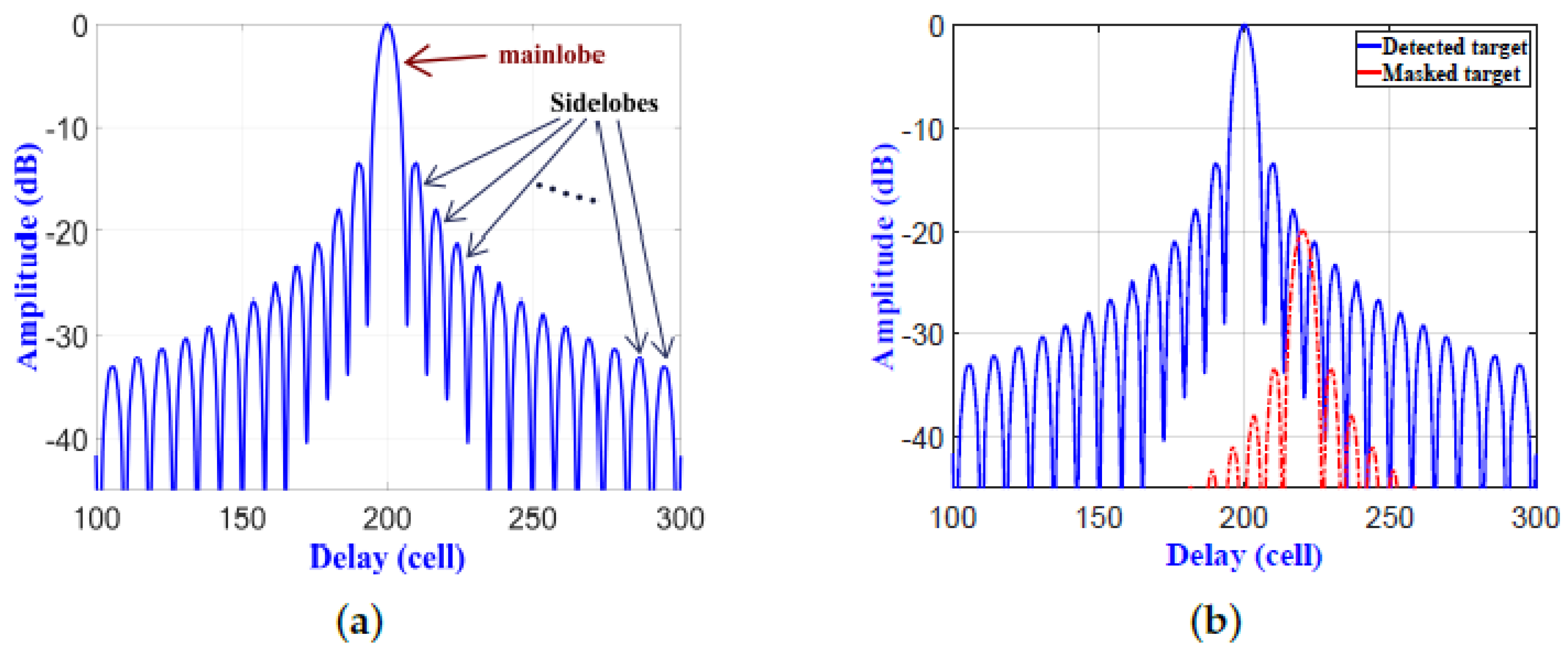
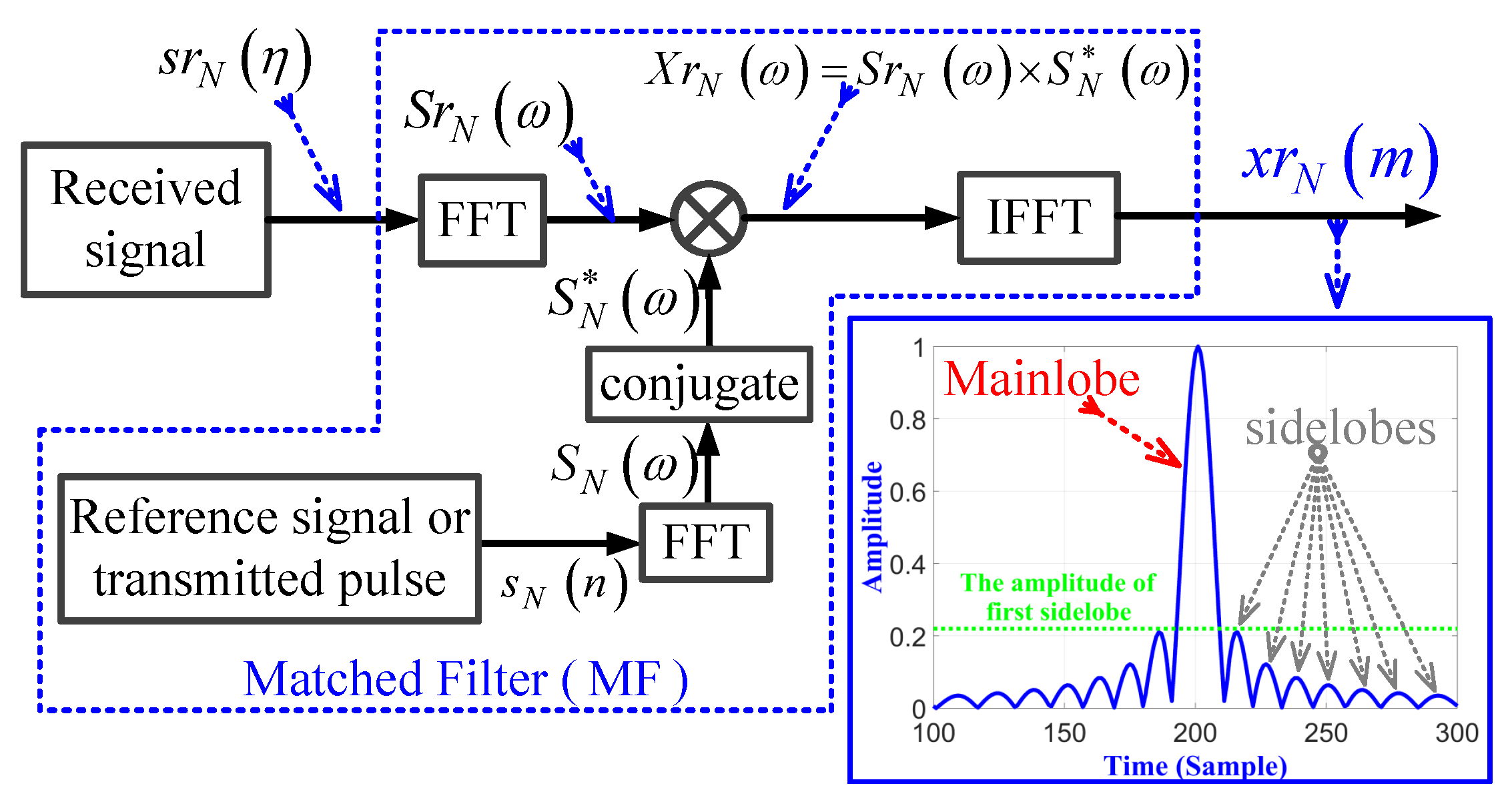
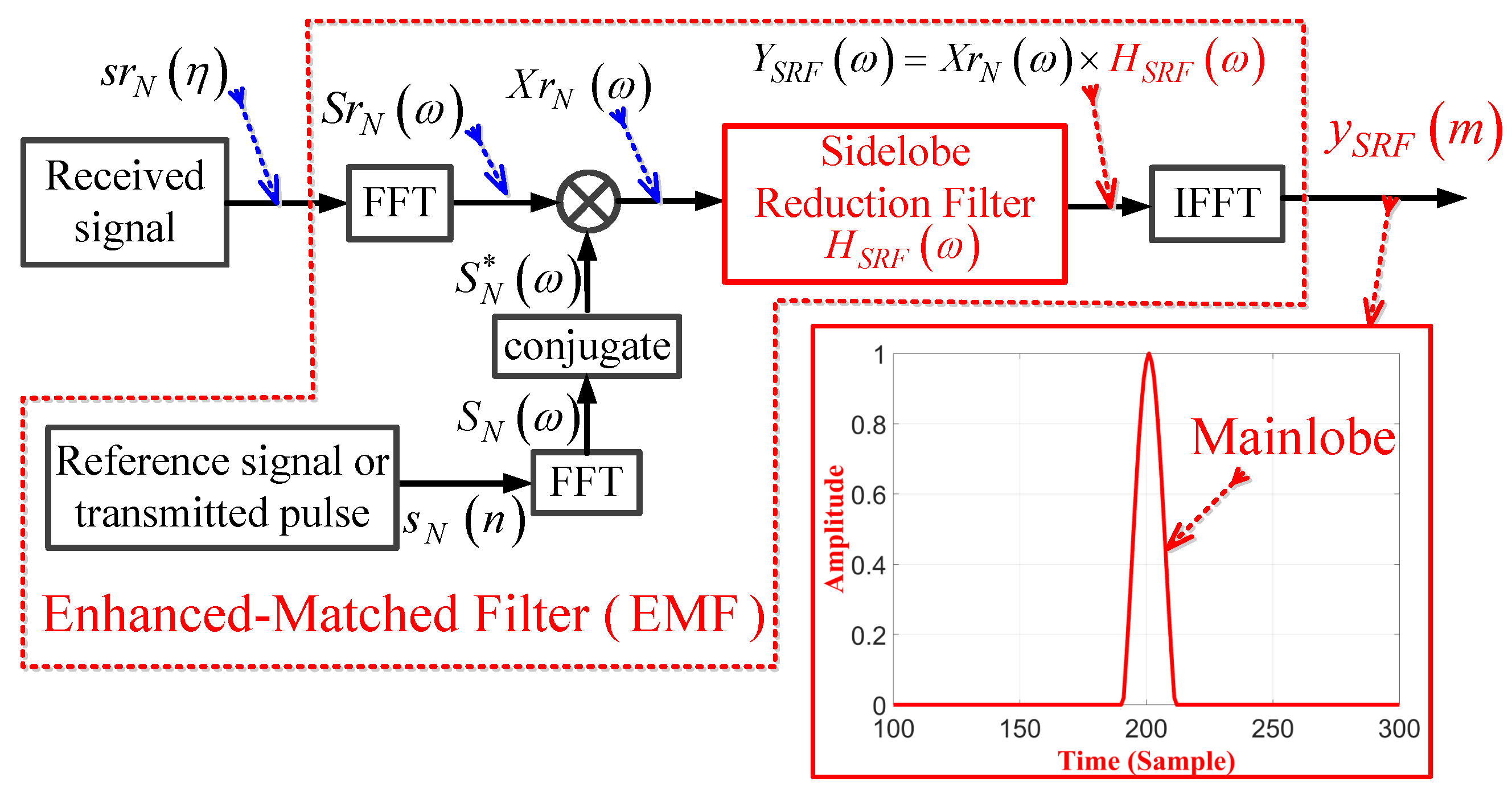
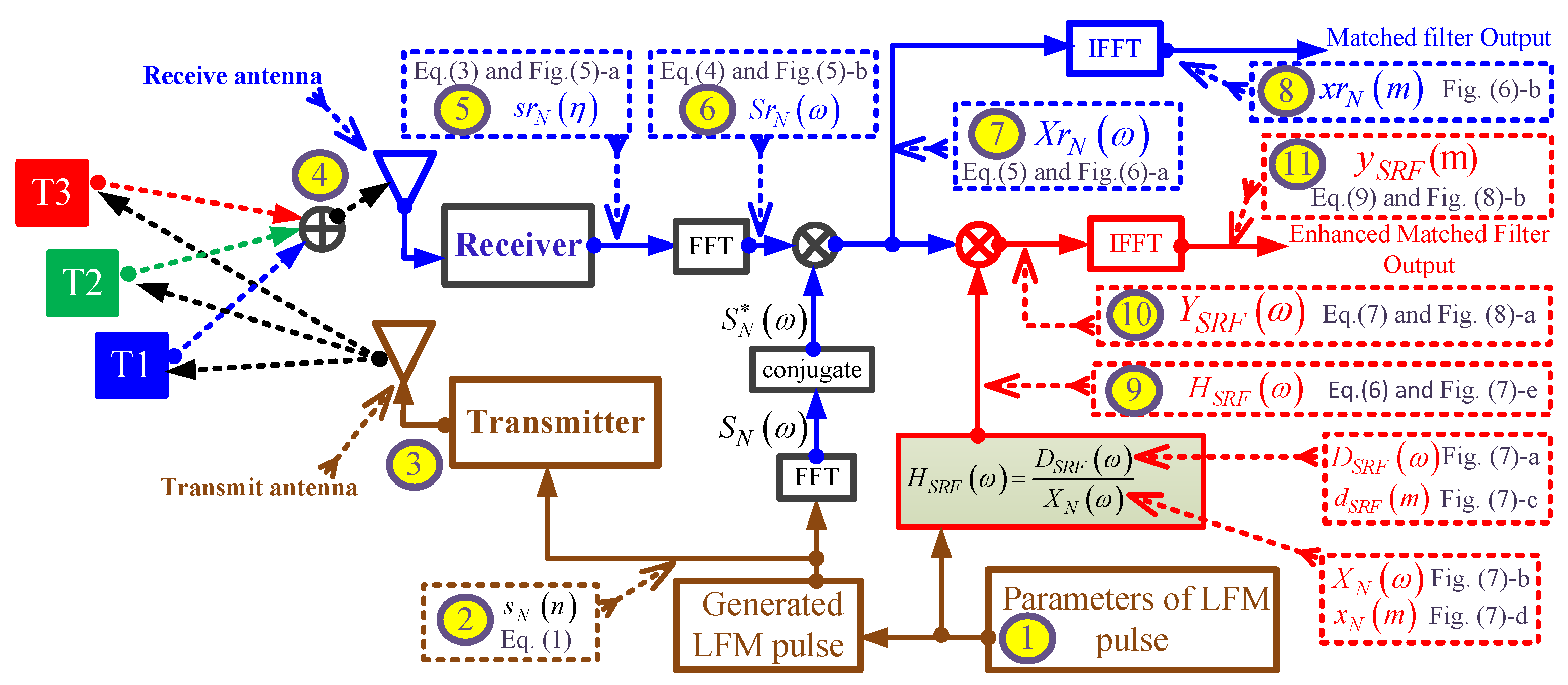

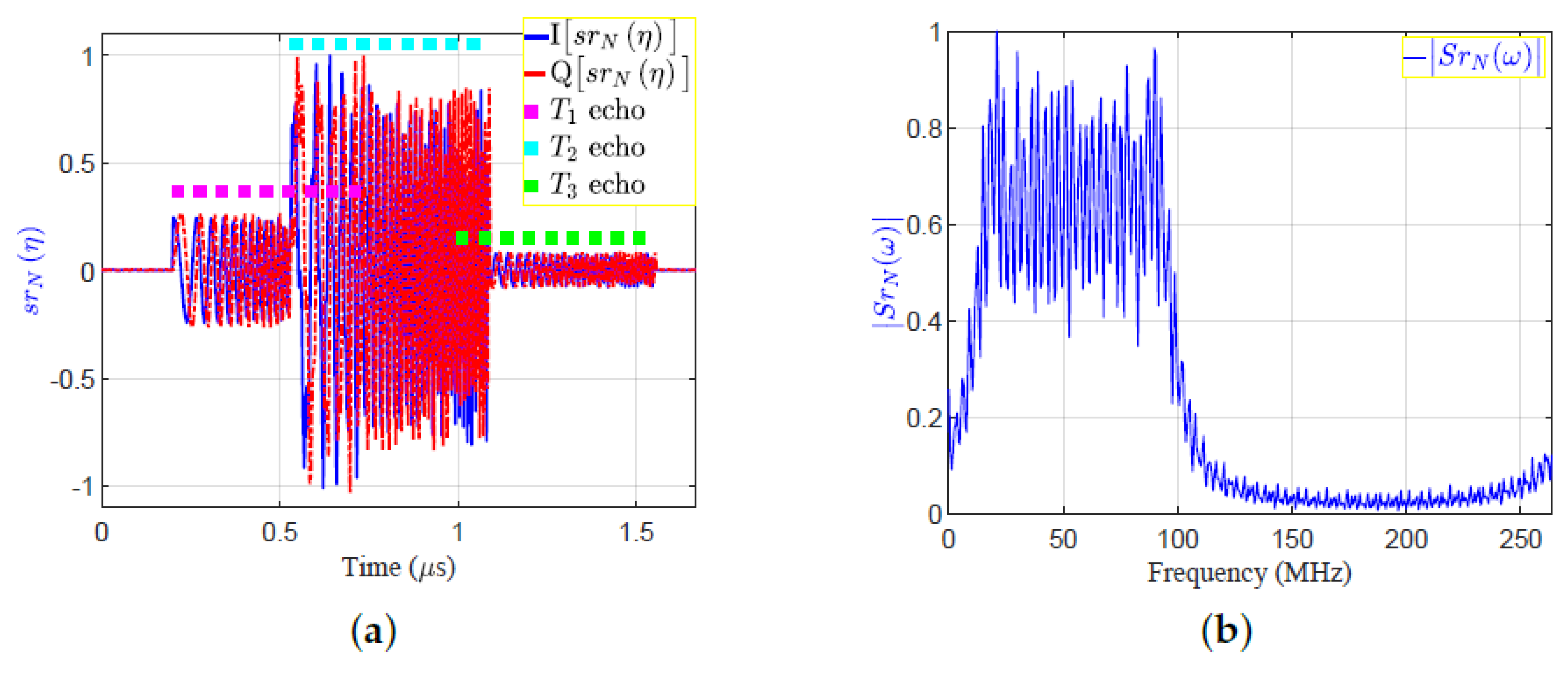


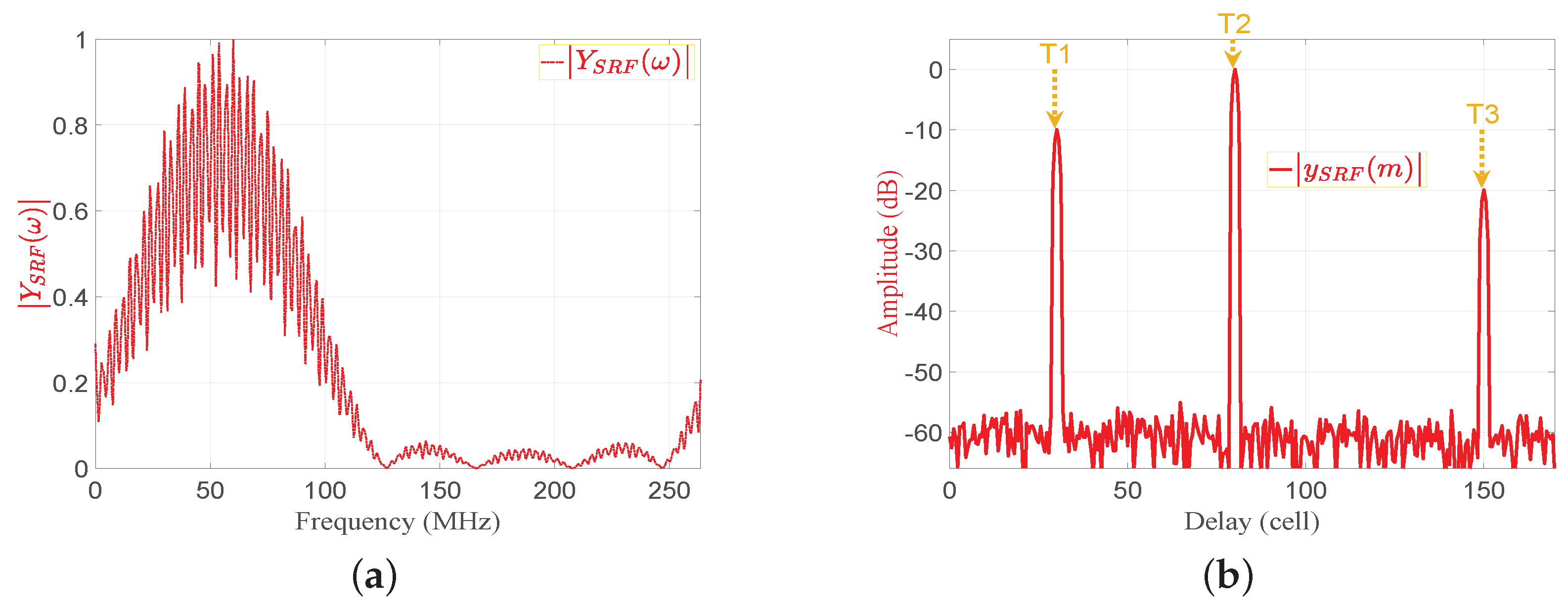
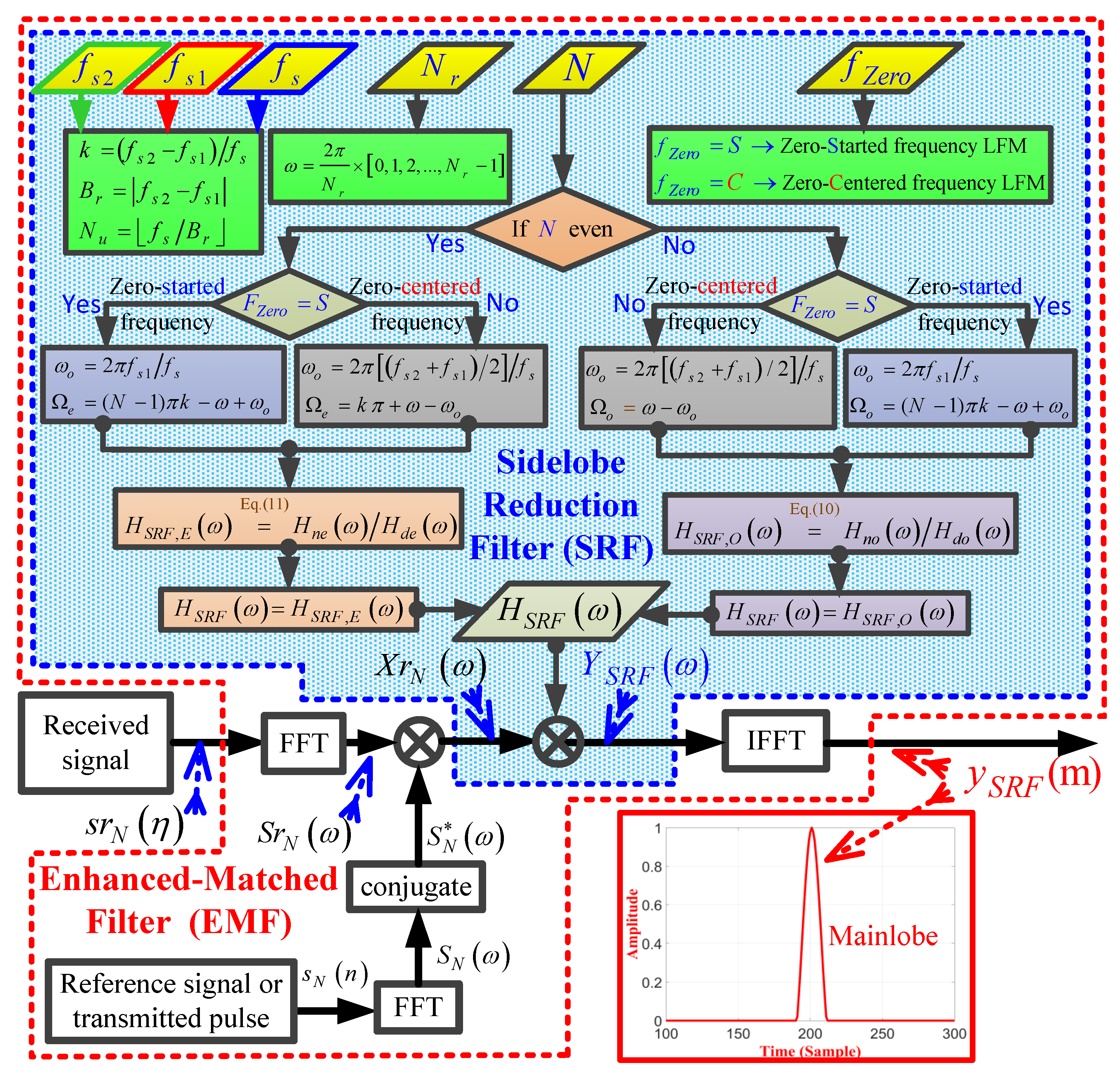
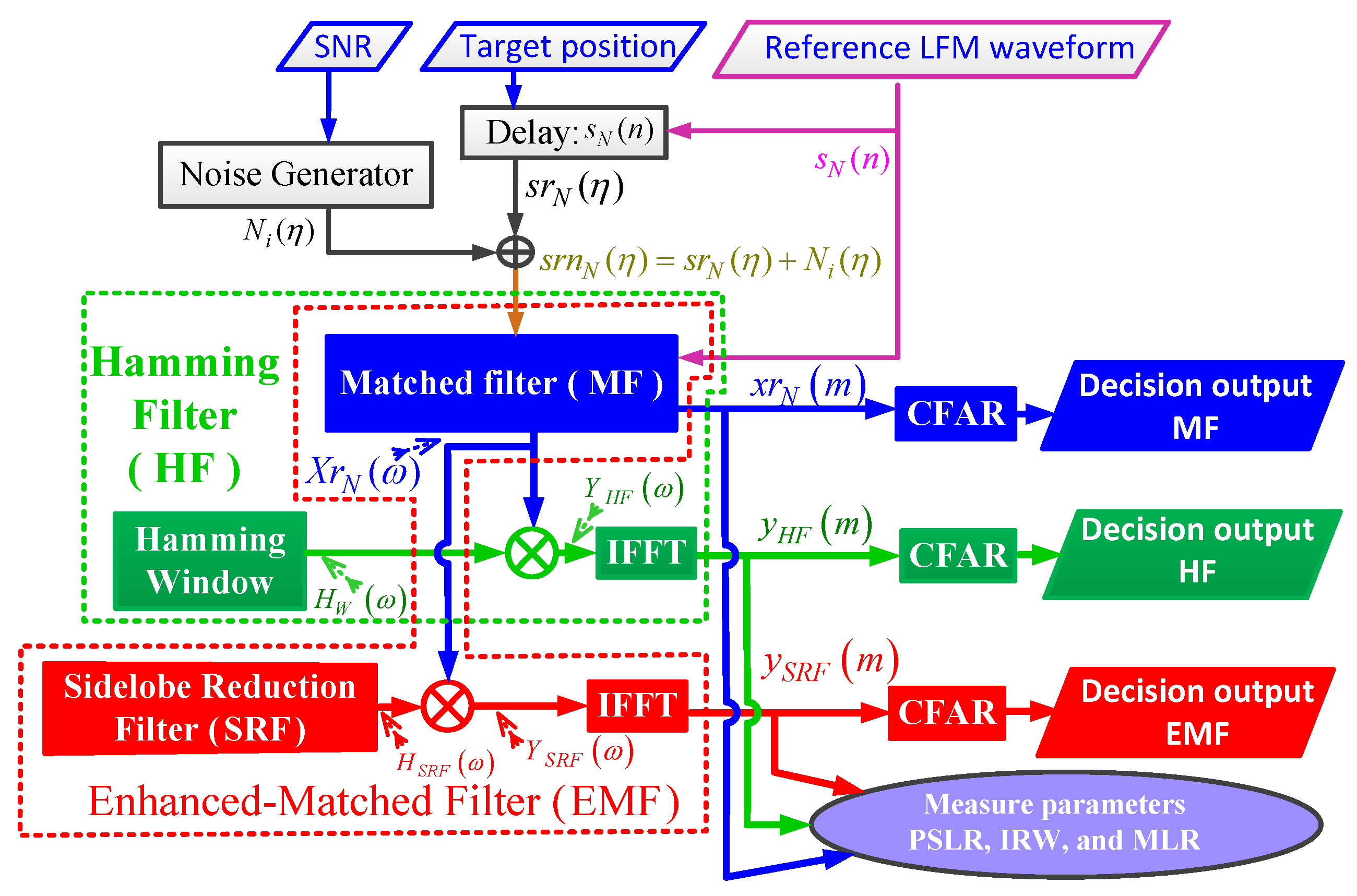
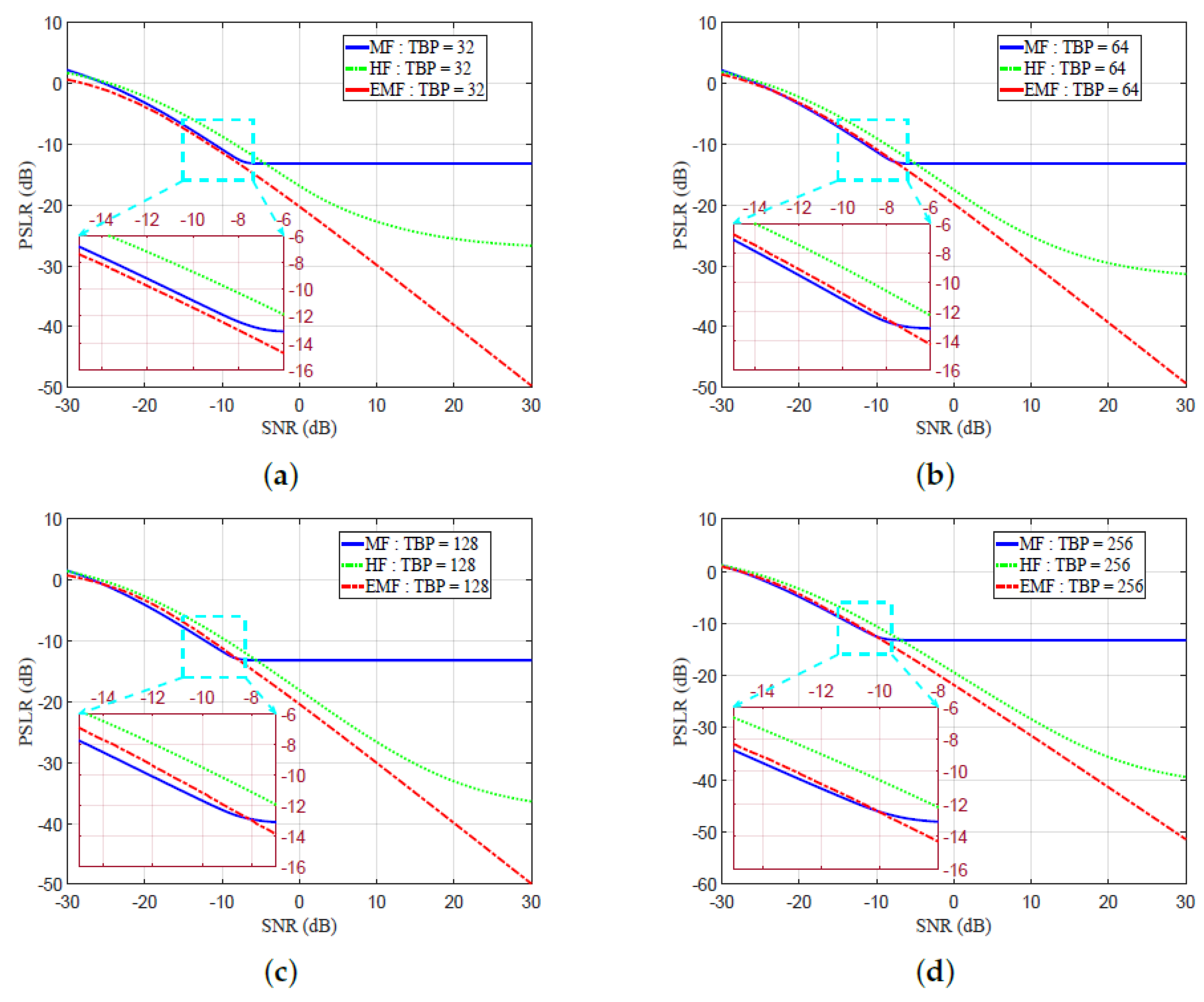

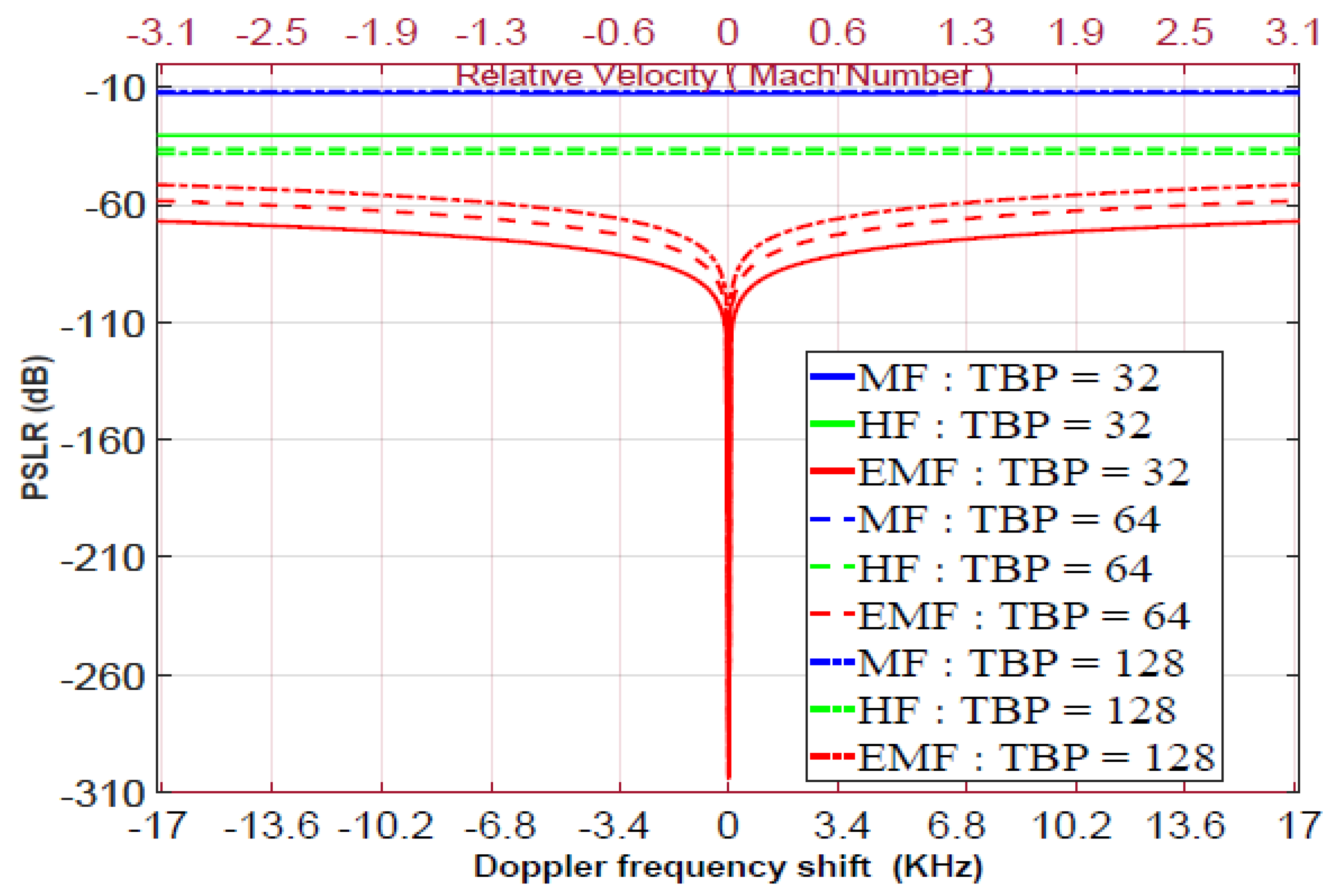
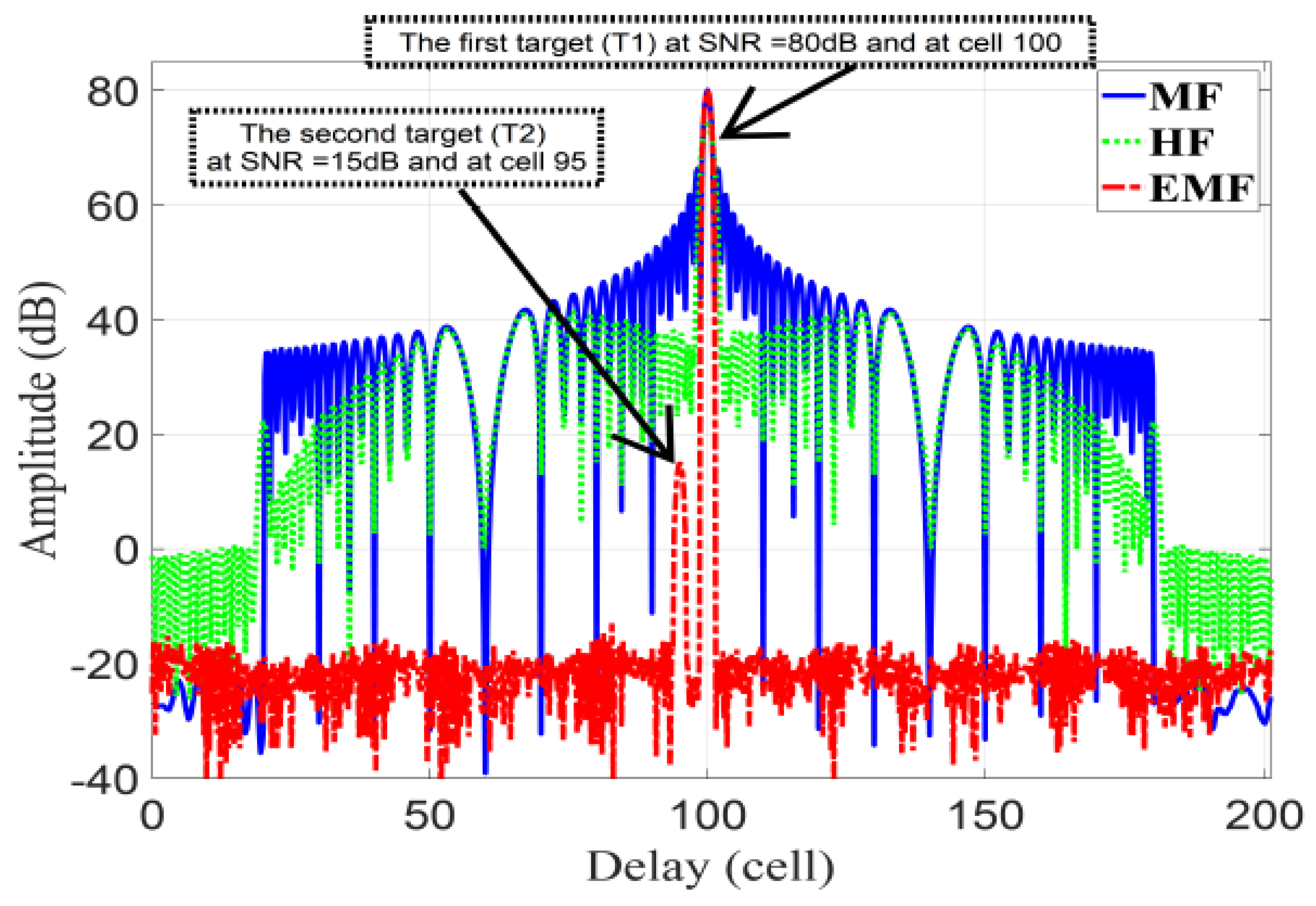
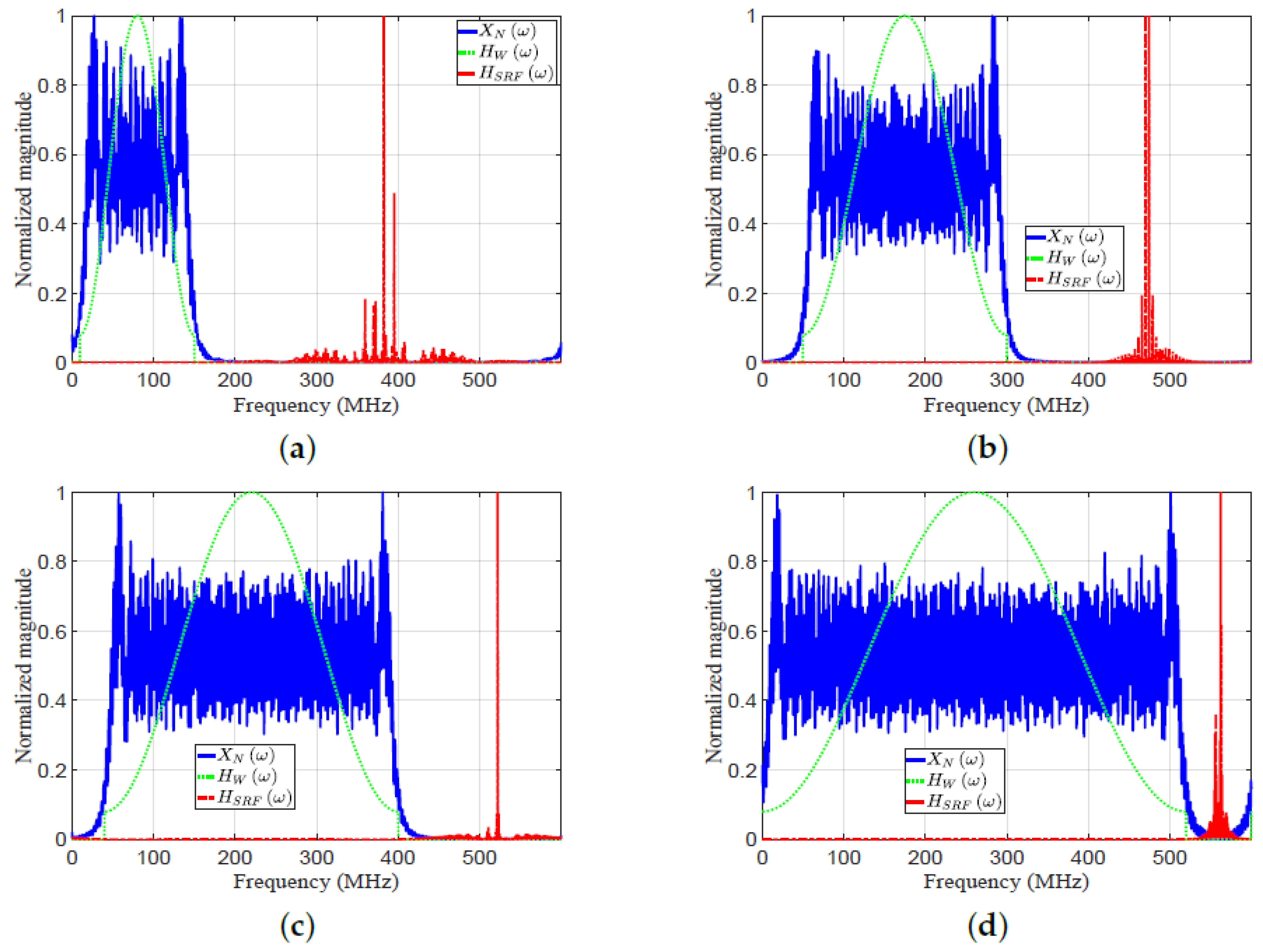
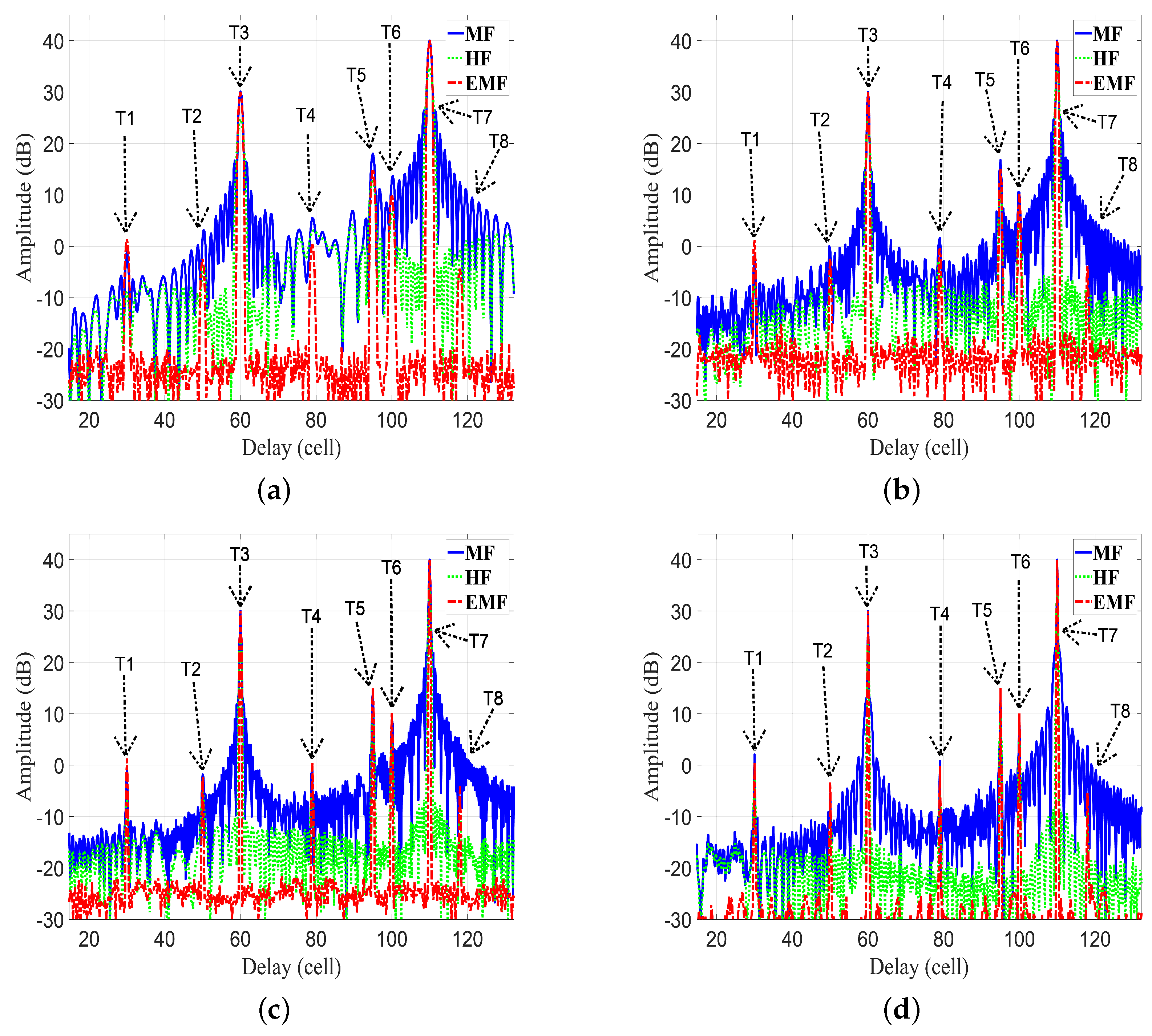

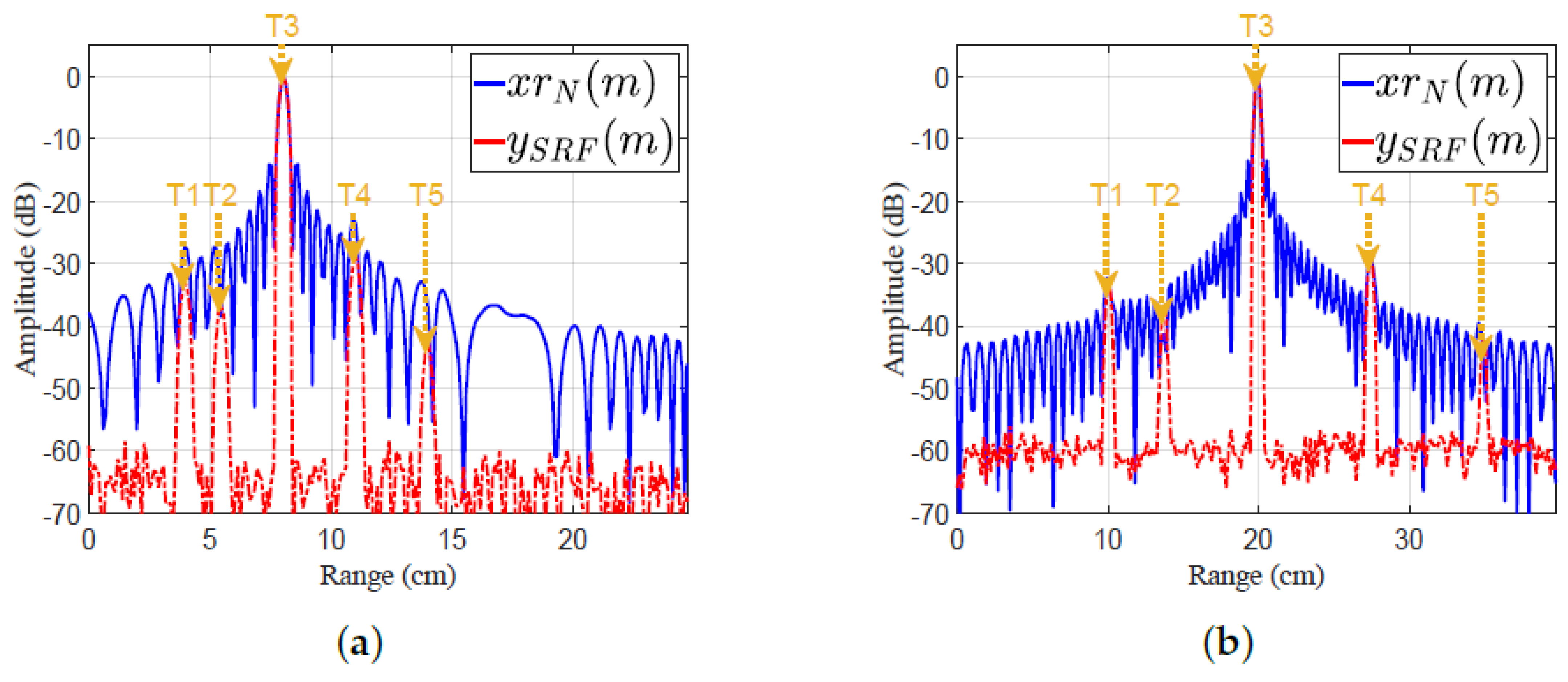
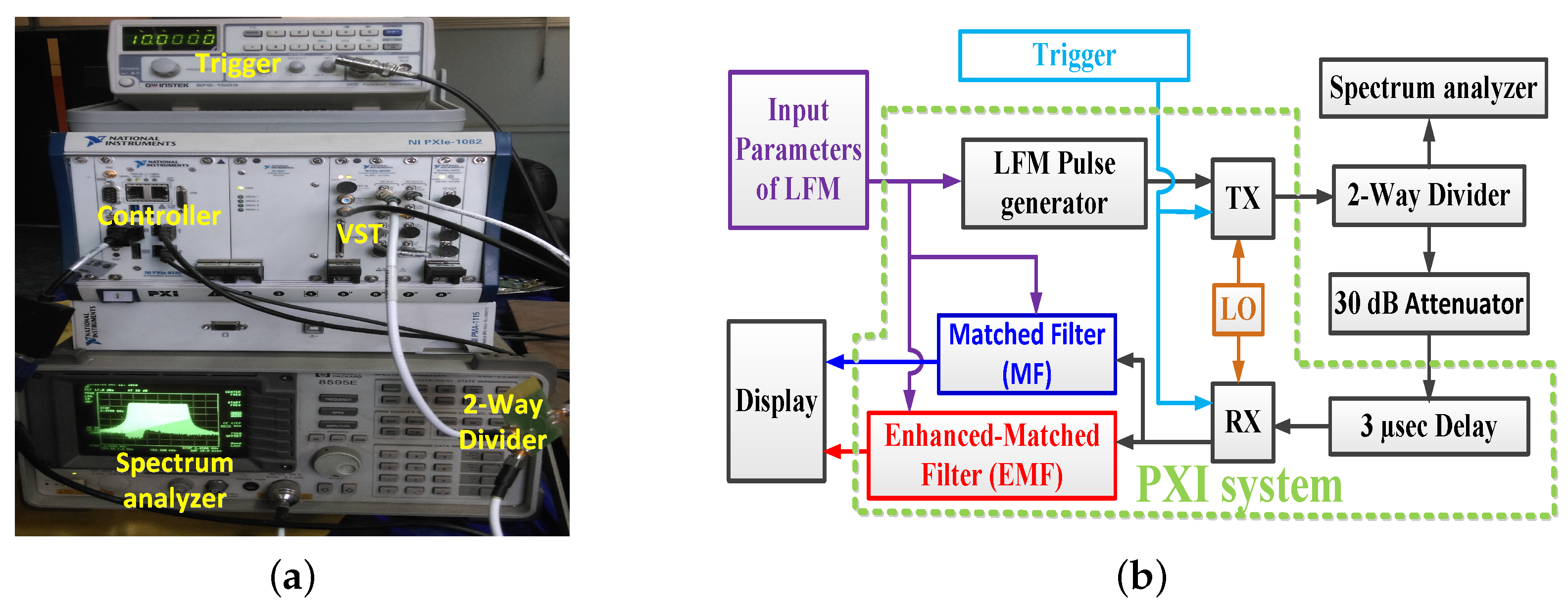


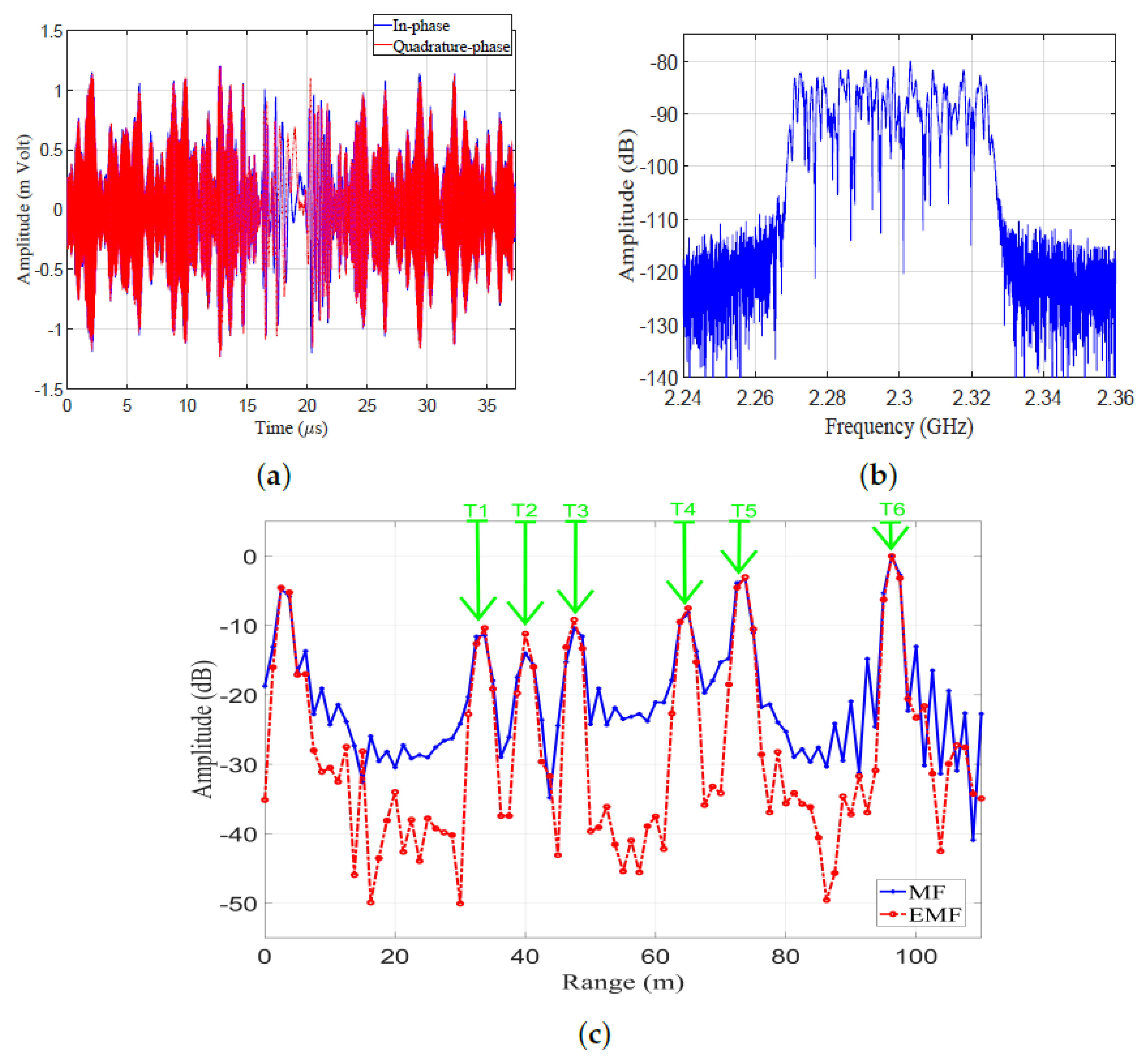
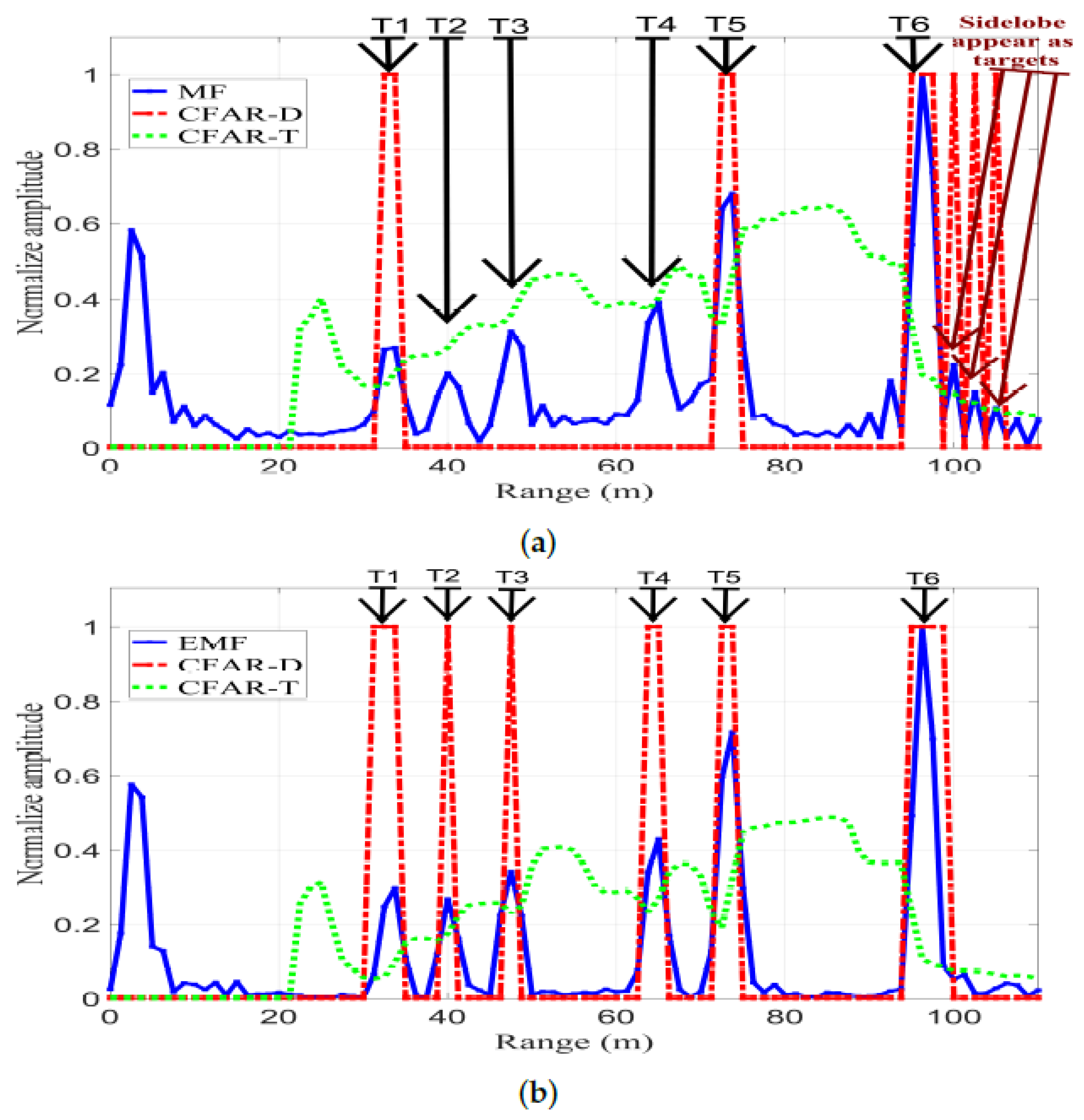
| TBP | Filter Type | dB | 0 dB | 10 dB | 20 dB |
|---|---|---|---|---|---|
| 32 | HF | ||||
| MF | |||||
| EMF | |||||
| 64 | HF | ||||
| MF | |||||
| EMF | |||||
| 128 | HF | ||||
| MF | |||||
| EMF |
| TBP | Filter Type | dB | 0 dB | 10 dB | 20 dB |
|---|---|---|---|---|---|
| 32 | HF | ||||
| EMF | |||||
| 64 | HF | ||||
| EMF | |||||
| 128 | HF | ||||
| EMF |
| EMF | MF | HF | [45] | |
|---|---|---|---|---|
| PSLR T1 (dB) | ||||
| IRW T1 (m) | ⋯ | |||
| PSLR T2 (dB) | ⋯ | ⋯ | ||
| IRW T2 (m) | ⋯ | ⋯ | ⋯ | |
| MLR T1(dB) | ⋯ | ⋯ |
| Target | Filter Type | PSLR (dB) | IRW (m) | MLR (dB) | |
|---|---|---|---|---|---|
| Figure 17a | MF | ⋯ | |||
| HF | |||||
| EHF | |||||
| MF | ⋯ | ||||
| HF | |||||
| EHF | |||||
| Figure 17b | MF | ⋯ | |||
| HF | |||||
| EHF | |||||
| MF | ⋯ | ||||
| HF | |||||
| EHF | |||||
| Figure 17c | MF | ⋯ | |||
| HF | |||||
| EHF | |||||
| MF | ⋯ | ||||
| HF | |||||
| EHF | |||||
| Figure 17d | MF | ⋯ | |||
| HF | |||||
| EHF | |||||
| MF | ⋯ | ||||
| HF | |||||
| EHF |
| Target | Filter Type | PSLR (dB) | IRW (cm) | MLR (dB) | |
|---|---|---|---|---|---|
| Figure 19a | MF | ⋯ | |||
| EHF | |||||
| MF | ⋯ | ⋯ | ⋯ | ||
| EHF | ⋯ | ||||
| Figure 19b | MF | ⋯ | |||
| EHF | |||||
| MF | ⋯ | ⋯ | ⋯ | ||
| EHF | ⋯ |
| Target | IRW (m) | PSLR (dB) | MLR (dB) | ||
|---|---|---|---|---|---|
| MF | EMF | MF | EMF | EMF | |
Publisher’s Note: MDPI stays neutral with regard to jurisdictional claims in published maps and institutional affiliations. |
© 2021 by the authors. Licensee MDPI, Basel, Switzerland. This article is an open access article distributed under the terms and conditions of the Creative Commons Attribution (CC BY) license (https://creativecommons.org/licenses/by/4.0/).
Share and Cite
Azouz, A.; Abosekeen, A.; Nassar, S.; Hanafy, M. Design and Implementation of an Enhanced Matched Filter for Sidelobe Reduction of Pulsed Linear Frequency Modulation Radar. Sensors 2021, 21, 3835. https://doi.org/10.3390/s21113835
Azouz A, Abosekeen A, Nassar S, Hanafy M. Design and Implementation of an Enhanced Matched Filter for Sidelobe Reduction of Pulsed Linear Frequency Modulation Radar. Sensors. 2021; 21(11):3835. https://doi.org/10.3390/s21113835
Chicago/Turabian StyleAzouz, Ahmed, Ashraf Abosekeen, Sameh Nassar, and Mohamed Hanafy. 2021. "Design and Implementation of an Enhanced Matched Filter for Sidelobe Reduction of Pulsed Linear Frequency Modulation Radar" Sensors 21, no. 11: 3835. https://doi.org/10.3390/s21113835
APA StyleAzouz, A., Abosekeen, A., Nassar, S., & Hanafy, M. (2021). Design and Implementation of an Enhanced Matched Filter for Sidelobe Reduction of Pulsed Linear Frequency Modulation Radar. Sensors, 21(11), 3835. https://doi.org/10.3390/s21113835









